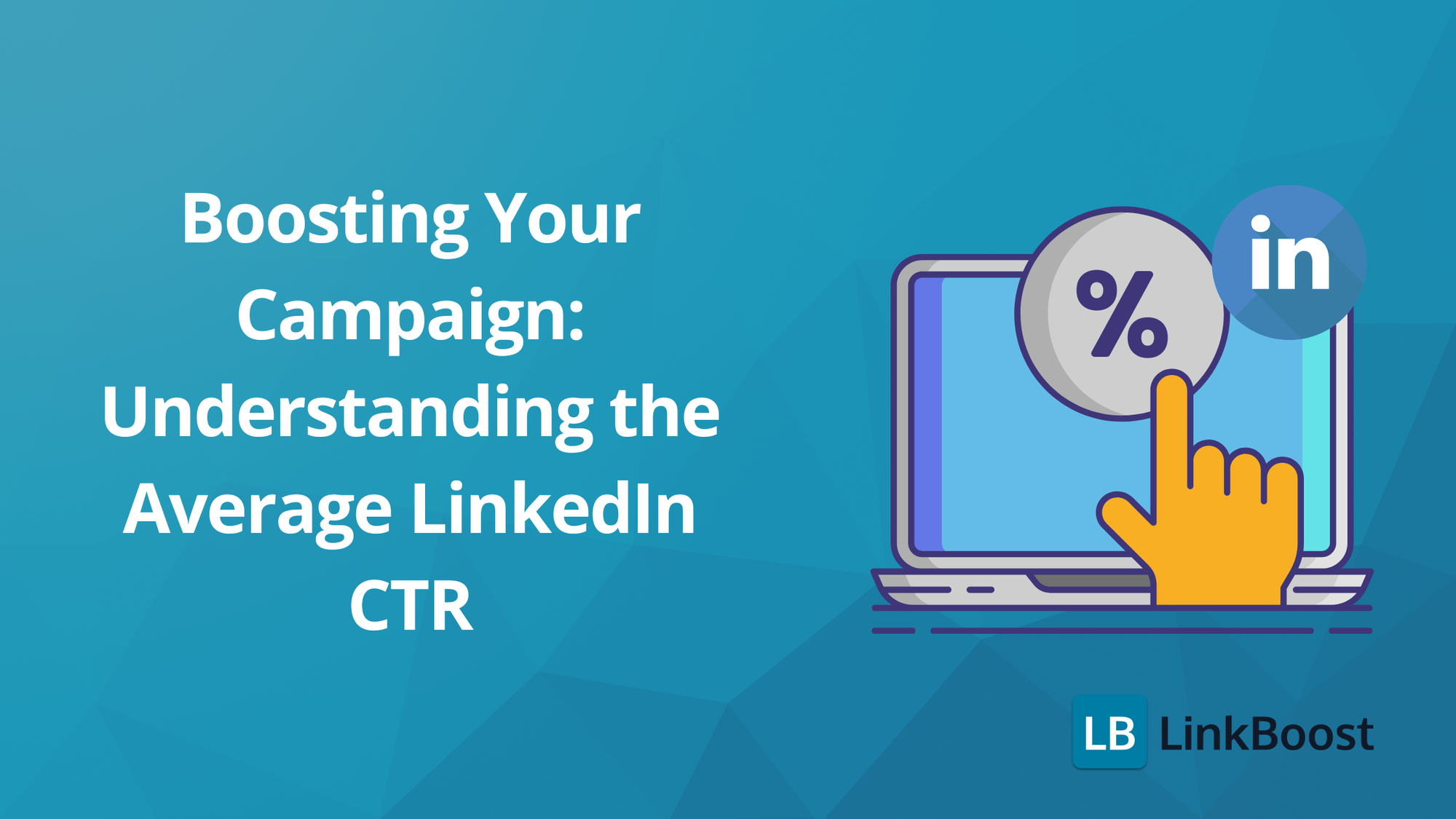Understanding the Average CTR for LinkedIn Ads: Boosting Your Campaign

Wondering if your LinkedIn ads are effective? Analyzing key LinkedIn Ads performance metrics, such as the average LinkedIn CTR, can help you gauge your performance. This article covers industry benchmarks and offers tips for improving your CTR.
- CTR, or Click-Through Rate, is a critical metric for evaluating the effectiveness of LinkedIn ads, as it measures engagement by comparing the number of clicks to the number of ad impressions.
- Benchmarking your LinkedIn ad’s CTR against industry standards, such as the average CTRs for different ad formats (e.g., 0.44% for Sponsored Content, 1.28% for Video Ads), helps set realistic goals and identify areas for improvement.
- Factors like ad creative quality, precise audience targeting, and optimal ad placement and timing significantly influence CTR, and strategies such as A/B testing, crafting engaging ad copy, and using eye-catching visuals are essential for improving this metric.

Understanding LinkedIn CTR
CTR, or Click-Through Rate, is a fundamental metric in digital advertising that measures the ratio of clicks on an ad to the total number of times it was shown. This percentage is valuable as it directly links with the engagement and effectiveness of your ads, particularly when considering the LinkedIn ads clickthrough rate. A higher CTR indicates that your ad is resonating well with your audience, driving more traffic to your landing page or website.
Monitoring CTR is not just about tracking clicks; it’s about gaining insights into your campaign’s performance and identifying opportunities to improve your return on investment (ROI). Understanding and fine-tuning your CTR enables you to make informed decisions that boost the overall prosperity of your LinkedIn advertising initiatives.
Definition of CTR
CTR is an acronym for Click-Through Rate, a metric used to evaluate the performance of online advertisements. By calculating the average click through rate, advertisers can better understand how well their ads are performing in terms of engagement. This is done by dividing the number of clicks on an ad by the number of ad impressions, then multiplying by 100 to get a percentage. For example, if your ad was shown 1,000 times and received 50 clicks, your CTR would be 5%.
The CTR reflects the ad’s engagement level by showing how many people clicked on it compared to how many times it was seen. Evaluating LinkedIn ads CTR is crucial as it indicates how effectively the ads engage users and drive them to take action. A superior CTR usually signifies that the ad is persuasive and pertinent to the viewers, conversely, a lower CTR might suggest a need for revisions in the ad creative, targeting, or both.
Why CTR is Crucial for LinkedIn Ads

CTR is a critical metric for LinkedIn ads because it helps determine the relevance and effectiveness of your ad to your target audience. Sponsored content ads, a popular ad type on LinkedIn that appears in users' news feeds, can significantly impact CTR due to their various formats and average click-through rates. A high CTR indicates that your ads are engaging and resonating with viewers, which can lead to better ad performance and more conversions.
Additionally, a higher CTR can lower your advertising costs because LinkedIn rewards ads that provide a good user experience by improving their visibility and ranking.
Grasping and fine-tuning for a solid CTR is vital for LinkedIn advertisers. It affects not only the visibility and ranking of your ads but also the overall cost-effectiveness of your campaigns. Whether you’re running text ads, carousel ads, or video ads, focusing on improving your CTR can lead to more successful and cost-efficient advertising efforts.
What are LinkedIn ad benchmarks?
LinkedIn ad benchmarks are standardized metrics that help advertisers measure the performance of their LinkedIn ad campaigns. These benchmarks provide a basis for comparison, allowing advertisers to evaluate their ad performance against industry averages and identify areas for improvement. By tracking key metrics such as click-through rate (CTR), cost per click (CPC), conversion rate, cost per impression (CPM), and cost per lead (CPL), advertisers can optimize their LinkedIn ad campaigns for better results.
Understanding LinkedIn ad benchmarks is crucial for setting realistic goals and expectations. For instance, knowing that the average CTR for Sponsored Content is 0.44% can help you determine whether your ad is performing above or below the industry standard. Similarly, benchmarks for CPC, CPM, and CPL can guide your budgeting and bidding strategies, ensuring that you get the most out of your ad spend.
Average LinkedIn CTR Benchmarks

To gauge the effectiveness of your LinkedIn ads, it’s helpful to compare your CTR against LinkedIn Ads benchmarks. These benchmarks provide a reference point, helping you understand how your ads stack up against others in your industry. In 2022, the mean CTR for LinkedIn carousel ads stood at 0.35% across all sectors and regions. This illustrates the performance of these ads on the platform. However, these numbers can vary significantly based on the type of ad and the industry you’re targeting.
Benchmarking your ad’s performance against these standards allows you to set realistic goals and identify areas for improvement. Comprehending average CTRs for various ad formats can steer your strategy in selecting the optimal ad types to enhance your campaign’s efficiency.
Average CTR for Sponsored Content
Sponsored Content is one of the most popular ad formats on LinkedIn, and it boasts an average CTR of 0.44%. This type of ad often appears in the LinkedIn feed, blending seamlessly with organic content, which can enhance its visibility and engagement. However, the CTR for Sponsored Content can vary depending on the region and industry.
For instance, LinkedIn carousel ads targeting IT Services showed the lowest CTR at 0.20% in 2022. Comprehending these variations can assist in customizing your ad strategy to align with the distinct preferences and behaviors of your target audience in various regions.
Average CTR for Text & Dynamic Ads
Text and Dynamic ads on LinkedIn also display varying CTRs. Dynamic ads, which are personalized to the viewer, generally have a higher average CTR of 0.08% compared to Text ads, which average around 0.025%.
These discrepancies underscore the significance of selecting the appropriate ad format rooted in your campaign goals and target audience, while also considering the ad spend for multiple campaigns, including paid ads.
Average CTR for Video Ads
Video ads on LinkedIn are notably efficient, showcasing a mean CTR of 1.28%. This higher engagement rate can be attributed to the dynamic and interactive nature of video content, which captures viewers' attention more effectively than static images or text.
A view is counted when the video is watched for at least 2 seconds, making it a powerful tool for conveying your message and driving clicks.
Average CTR for Message Ads
Message Ads, also known as Sponsored Messages, have some of the highest engagement rates on LinkedIn. They boast an average open rate of 55% and a high CTR of around 7%. These ads are delivered directly to the LinkedIn inboxes of your target audience, making them highly personalized and engaging.
The high CTR of Message Ads indicates their effectiveness in capturing the audience's attention and driving engagement. This format is particularly useful for personalized outreach and direct communication with potential leads, making it a valuable addition to your LinkedIn advertising strategy.
Key metrics to track: CTR, CPC, Conversion Rate, CPM, and CPL
When it comes to LinkedIn advertising, there are several key metrics to track to ensure the success of your ad campaigns. Here are five essential metrics to monitor:
- Click-Through Rate (CTR): The percentage of users who click on your ad after seeing it in their feed. A higher CTR indicates that your ad is relevant and engaging to your target audience. Monitoring CTR helps you understand how well your ad resonates with viewers and can guide adjustments to improve engagement.
- Cost Per Click (CPC): The cost of each click on your ad. CPC is influenced by factors such as ad format, targeting options, and competitive landscape. Keeping an eye on CPC helps you manage your ad spend effectively and ensures that you are getting value for your investment.
- Conversion Rate: The percentage of users who complete a desired action after clicking on your ad, such as filling out a form or making a purchase. A high conversion rate indicates that your ad is not only attracting clicks but also driving meaningful actions. This metric is crucial for evaluating the overall effectiveness of your ad campaigns.
- Cost Per Impression (CPM): The cost of 1,000 ad impressions. CPM is influenced by factors such as ad size, placement, and targeting options. Understanding CPM helps you gauge the cost-effectiveness of your ad placements and optimize your budget allocation.
- Cost Per Lead (CPL): The cost of capturing a lead, which can vary greatly depending on audience type, offer, and ad creatives. Monitoring CPL helps you assess the efficiency of your lead generation efforts and make necessary adjustments to improve ROI.
Factors Influencing LinkedIn CTR
Several factors can influence the CTR of your LinkedIn ads. Understanding these factors can help you optimize your campaigns for better performance. Ad creative quality, audience targeting, and ad placement and timing are among the most critical elements that affect LinkedIn CTR.
Concentrating on these factors can assist you in crafting more engaging ads that strike a chord with your target audience, culminating in enhanced engagement and superior campaign outcomes.
Ad Creative Quality
The caliber of your ad creatives considerably influences your CTR. Here are some tips to improve your ad creatives and boost your CTR:
- Create high-quality ads with clear and compelling calls-to-action (CTAs). This can boost CTR by 37%.
- Maintain a professional tone in your ad creatives on LinkedIn. This can result in a 22% higher CTR.
- Unlike other platforms, the image-to-text ratio on LinkedIn does not significantly alter the CTR.
Creating a strong LinkedIn profile with a professional photo and a compelling headline can also significantly boost CTR. These elements help establish credibility and make your ads more appealing to your target audience.
Audience Targeting
Accurate audience targeting is vital for enhancing CTR. By leveraging LinkedIn's targeting options, such as job titles, industries, and demographic insights, you can ensure that your ads reach the most relevant users. Understanding LinkedIn's audience, including their industry, job roles, and challenges, is essential for crafting effective ad copy.
Using LinkedIn's Audience Expansion feature can help you reach new audiences similar to your target audience, thereby increasing your ad's reach and engagement. Including job type and relevant details in your profile can make your ad copy more relatable and credible.
Ad Placement and Timing
Refining ad placement and timing is another vital factor that can boost your CTR. Aligning your ad placement and timing with user behavior patterns ensures that your ads are seen when your target audience is most active and engaged.
This strategic approach can significantly improve your ad performance and CTR.
Strategies to Improve Your LinkedIn CTR

Boosting your LinkedIn CTR necessitates a tactical approach encompassing the creation of engaging ad copy, utilization of attention-grabbing visuals, and A/B testing of your ads. These strategies help ensure that your ads are not only seen but also clicked on by your target audience.
By continuously testing and refining your ad elements, you can identify what works best for your audience and optimize your campaigns for better performance.
Compelling ad copy is essential for grabbing attention and encouraging clicks. LinkedIn ad copy should be concise, clear, and free from jargon. Strong headlines that include numbers, questions, or compelling adjectives can also boost engagement.
Highlighting the value and benefits of your product or service is crucial in LinkedIn ads. A compelling call-to-action (CTA) can significantly increase click-through rates. Personalizing ad copy to address specific audience pain points can lead to higher CTRs.
Utilizing Eye-Catching Visuals
High-quality visuals that align with your brand identity can enhance engagement and recall in LinkedIn ads. Square images and videos tend to perform better on LinkedIn, with square videos outperforming other formats by 50%.
Using visuals that evoke emotions relevant to your target audience can make your ads more compelling. This strategy not only captures attention but also enhances the overall effectiveness of your ad campaigns.
A/B Testing Your Ads
A/B testing different ad elements is crucial for refining ad creatives and improving LinkedIn ad CTR. Testing different variations helps identify the most effective headlines and images, maximizing ad performance.
Regularly A/B testing your campaigns helps identify what resonates best with your audience and improves ad performance. Continuous optimization based on A/B test results is key to achieving better campaign outcomes.
LinkedIn Location Targeting
LinkedIn location targeting allows you to target your ads to specific geographic regions, ensuring that your message reaches the right audience. You can target by country, state, region, city, or county, making it easier to reach your desired audience. By targeting specific locations, you can increase the relevance of your ads and improve their performance.
For example, if your business operates in multiple regions, you can create tailored ad campaigns for each location, addressing the unique needs and preferences of local audiences. This level of precision in targeting helps maximize the impact of your LinkedIn ads and ensures that your marketing efforts are aligned with your business goals.
Measuring and Analyzing CTR Performance
Quantifying and scrutinizing CTR performance is crucial in comprehending your LinkedIn ads' performance and pinpointing areas for enhancement. Key metrics to monitor include:
- Clicks
- Impressions
- CTR
- Average engagement for brand awareness campaigns.
For lead generation and conversion-focused campaigns, key metrics include:
- Conversions
- Conversion rate
- Cost per conversion
- Leads
- Cost per lead
By regularly tracking these metrics, you can gain valuable insights into your ad performance and make data-driven decisions to optimize your campaigns.
Setting Up Tracking in Campaign Manager
Establishing tracking for CTR in LinkedIn Campaign Manager entails choosing apt metrics during the campaign creation process. LinkedIn supports tracking and attribution using Moat and Google Marketing Platform for Text Ads, Dynamic Ads, and Sponsored Content.
Interpreting CTR Data
Interpreting CTR data involves analyzing the performance of your ads and identifying areas for improvement. A low CTR often suggests that the ad content or targeting needs adjustment. Establishing a baseline by noting key metrics from initial ad campaigns can help measure growth over time.
Adjusting Campaigns Based on CTR Analysis
Modifying your campaigns grounded on CTR analysis is vital for optimizing ad performance. Poor CTR performance should prompt a review of audience targeting and ad creative. Comparing CTR across different ads helps identify the most effective messaging and visuals.
Continuous optimization of LinkedIn ad copies through A/B testing and adjusting bids and budgets based on CTR can significantly improve LinkedIn advertising campaigns performance while managing LinkedIn ad costs effectively, including the consideration of a minimum lifetime budget.
Understanding and optimizing CTR is crucial for the success of your LinkedIn advertising campaigns. By leveraging benchmarks, focusing on key factors influencing CTR, and implementing effective strategies, you can significantly enhance your ad performance and ROI.
As you continue to monitor and adjust your campaigns based on CTR analysis, remember that continuous optimization and testing are key to achieving long-term success. Embrace these insights and strategies to make your LinkedIn ads more engaging and effective.
Cost Per Click (CPC) Benchmark
The global average cost-per-click (CPC) for LinkedIn Ads is $5.58. However, CPC can vary depending on factors such as ad format, targeting options, and competitive landscape. For example, CPCs for job functions such as Software & IT, Finance, and Education can range from $2.20 to $3.50. By understanding the CPC benchmark, you can set realistic expectations for your ad campaigns and optimize your bidding strategy.
Knowing the average CPC helps you budget effectively and ensures that you are not overspending on clicks. It also allows you to compare your campaign performance against industry standards and make data-driven decisions to enhance your LinkedIn advertising efforts.
Engagement Rate Benchmark on LinkedIn
Engagement rate measures the number of times people engage with your ad, such as likes, comments, and shares. The engagement rate benchmark on LinkedIn varies by region and industry. For example, the engagement rate for sponsored content in North America is higher than in Europe. By tracking engagement rate, you can gauge the effectiveness of your ad creative and targeting strategy.
A high engagement rate indicates that your ad is resonating well with your audience, prompting them to interact with your content. This metric is essential for understanding how well your ads are performing in terms of user interaction and can provide insights into areas for improvement. By continuously monitoring and optimizing for engagement, you can enhance the overall impact of your LinkedIn ad campaigns.
What is a good CTR for LinkedIn ads?
A good CTR for LinkedIn ads varies by ad format and industry, but generally, a CTR of 0.44% for Sponsored Content and 1.28% for Video Ads is considered good.
To improve your LinkedIn ad CTR, focus on creating engaging ad copy, using captivating visuals, and conducting A/B testing for optimization. These steps can help enhance your ad performance and drive better results.
Why is CTR important for LinkedIn advertising campaigns?
CTR is important for LinkedIn advertising campaigns because it measures the effectiveness and relevance of your ads, leading to improved ad visibility, ranking, and reduced costs. This helps in optimizing the campaign for better results.
The quality of ad creative, audience targeting, and ad placement and timing are key factors that influence LinkedIn ad CTR. These elements play a crucial role in the performance of your ads.
How do I set up tracking for CTR in LinkedIn Campaign Manager?
When setting up a campaign in LinkedIn Campaign Manager, you can track CTR by selecting the appropriate metrics and utilizing tools like Moat and Google Marketing Platform for tracking and attribution. Utilize these options during the campaign creation process to effectively monitor CTR.

